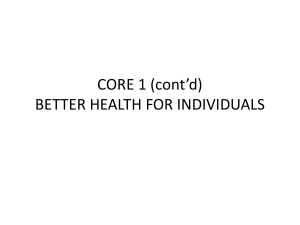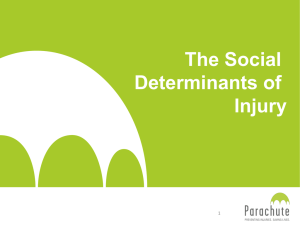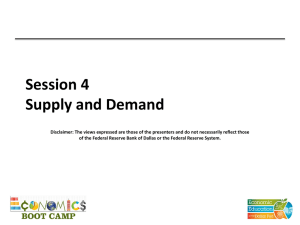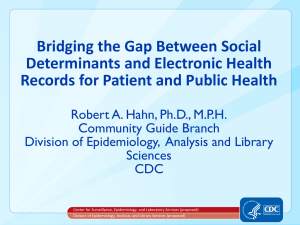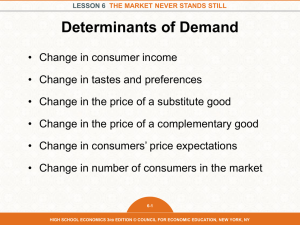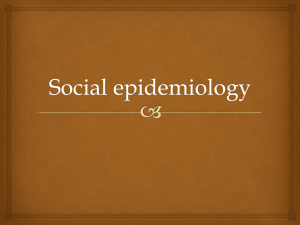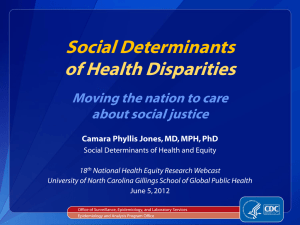World Health Organization
advertisement
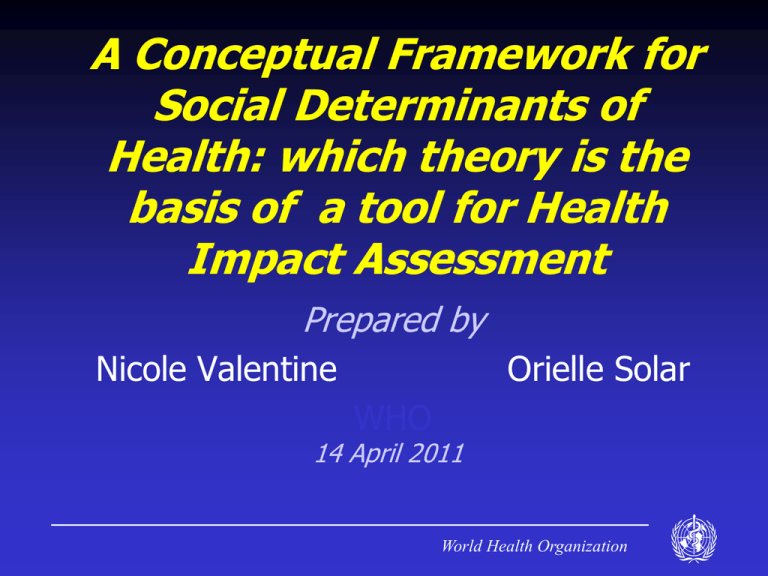
A Conceptual Framework for Social Determinants of Health: which theory is the basis of a tool for Health Impact Assessment Prepared by Nicole Valentine Orielle Solar WHO 14 April 2011 World Health Organization ………. World Health Organization Norway 2006 WHO Commission on Social Determinants of Health 2005 – 2008 Areas of work of the Commission on Social Determinants of Health Country action The Commission supported countries to develop policies that address the social causes of poor health and inequities. Civil society Civil society organizations from all regions provided vital inputs to the Commission's work. Knowledge networks The networks collated knowledge and evidence to support policy design and action. http://www.who.int/social_determinants/en World Health Organization Current directions in Social Determinants theory “……. called theories of social production of disease which presume but cannot be reduced to mechanism–oriented theories of disease causation ” World Health Organization The Determinants of Health and the Determinants of Inequalities in Health The policies aimed at tackling the determinants of health are not also automatically tackling the determinants of health inequalities. Tackling the determinants of health inequalities is about tackling the unequal distribution of health determinants. Actions on health determinants are likely to focus on reducing overall exposure to health damaging factors along the causal pathway. Actions on unfair health inequality determinants are likely to focus on levelling up distribution of major or structural determinants. World Health Organization Where do health differences among social groups originate, if we trace them back to their deepest roots? What pathways lead from root causes to the stark differences in health status observed at the population level? World Health Organization Social Context Social Position A B Specific exposure C Policy Context Disease / injury D Social Consequences of ill health Dahlgren and Whitehead Diderichsen Adult socioeconomic position Incidence of health problems at adult ages 1 1 1 2 2 1 d.- childhood environment e.- cultural factors f.- psychological factors a.- Lifestyle factors b.- structural/environmental factors. c.- psychosocial stress-related factors. 2 g.- health in childhood Marmot 2 Mackenbach World Health Organization 1 Question: Where do health differences among social groups originate, if we trace them back to their deepest roots ? World Health Organization World Health Organization Socioeconomic context Structural and intermediate determinants SOCIAL POSITION Social prestige Political context SOCIAL POSITION Education Employment Political power Wealth Economic class Gender & Ethnicity / racism POWER POWER Intermediate determinants Material circumstances of life and work Psycosocial factors Behavioural and biological factors Health systems Social cohesion World Health Organization Equity in health and wellbeing ‘‘Socioeconomic position’’ (SEP) refers to the social and economic factors that influence what positions individuals or groups hold within the structure of a society, A variety of other terms, such as social class, social stratification, social or socioeconomic status, are often used interchangeably despite their different theoretical bases and, therefore, interpretations. SEP is related to numerous exposures, resources, and susceptibilities that may affect health. World Health Organization Question: Where do health differences among social groups originate, if we trace them back to their deepest roots ? Answer: Health inequities flow from patterns of social stratification— founded on the systematically unequal distribution of political power, prestige and resources among groups in society. World Health Organization Question : What pathways lead from root causes to the stark differences in health status observed at the population level? World Health Organization The structural determinants operate through a series of what we will term intermediary social factors or social determinants of health, in a more restricted sense. The intermediary factors flow from the configuration of underlying social stratification and, in turn, determine : – differences in exposure to health-compromising conditions; – differences in vulnerability, in terms of health conditions and material resources available; – Differences in consequences of social, economic and health nature. The main categories of intermediary determinants of health are: 1. 2. 3. 4. material circumstances; psychosocial circumstances; behavioral and/or biological factors; and the health system itself as a social determinant. World Health Organization World Health Organization Question : What pathways lead from root causes to the stark differences in health status observed at the population level? Answer : Pathways from root causes to observed inequities in health, operate through a set of what we call intermediary determinants of health and unequal distribution of them (through differential exposure and vulnerability) that shape health outcomes. World Health Organization In light of the answers to the first two questions, where and how should we intervene to reduce health inequities? World Health Organization We must reflect carefully about the policy level(s) where they will aim to promote change Interventions on intermediate social determinants or pathways .- Differential exposure .- Differential vulnerability .- Improving health system access .- Differential consequences IMPACT ON HEALTH OUTCOMES, BUT NOT NECESSARILY ON HEALTH INEQUITIES Interventions on structural social determinants (social position) .- Income .- Education .- Gender .- Social cohesion .- Regeneration of communities IMPACT ON HEALTH INEQUITIES, BUT MORE POLITICALLY CHALLENGING World Health Organization When we develop HIA in a specific context …….. are we including the theory of health inequality in this evaluation ? Are we addressing structural determinants of health ? World Health Organization Conclusions and Open Questions Tackling health disadvantage is good but insufficient; equity requires narrowing gaps and above all reducing gradients Determinants of health are not the same as determinants of health inequities. Direct action on structural SDH is often technically and politically difficult Can the Health use pathways for indirect impact on structural determinants, while advocating for deeper change? Health equity interventions cannot be sustained without a broad policy commitment to SDH (in its broader understanding) – This implies new way of framing health goals Gracias World Health Organization


